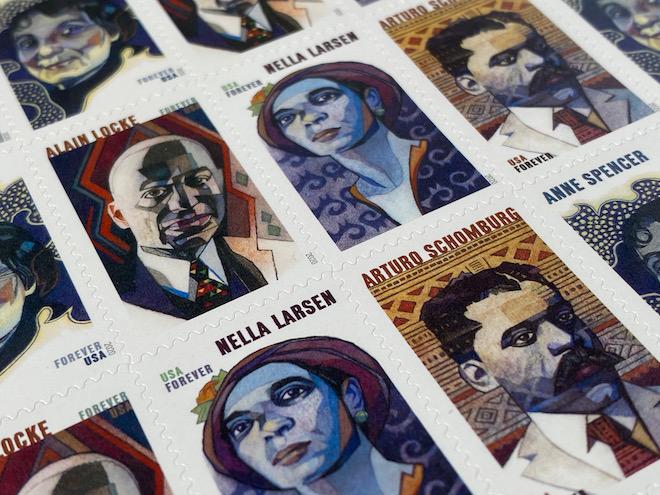Put a Stamp on It: How Art Director Greg Breeding Helps the USPS Create New Stamps

This past May, the United States Postal Service (USPS) released four new stamps—Voices of the Harlem Renaissance—comprising images of Nella Larsen, Alaine Locke, Arturo Alfonso Schomburg, and Anne Spenser. The stamps were among the roughly 20 new editions the USPS releases each year, reflecting a wide range of interests from paleontology to pop culture to notable Americans and, as is the case with these stamps, important cultural movements in U.S. history.
Designer Greg Breeding, who leads the independent design firm the Journey Group, is one of four art directors who regularly works with the USPS to bring new stamps to life. He quipped that that the position is a lot like the conductor of an orchestra. As he described it, “An art director’s responsibility is to lead and facilitate, provide direction, and hopefully some aesthetic vision for stamp design.” When working on projects for the Post Office, Breeding leads a team that includes researchers as well as artists such as painters, illustrators, photographers, and typographers.
Although digital platforms have become the dominant mode of communication in the 21st century, Breeding thinks that stamps still have an important role to play in American life. He explained, “These national and international stamp programs are ways of every country telling their own story. To use language of our day, it might be considered as a country's brand. So there is, in most countries of the world, real pride in being able to issue stamps that honor their citizens and tell their story.”
The years-long process of creating a new stamp, or series of stamps, starts with the general public, who are encouraged by the USPS to submit their ideas for what they’d like to see as a stamp. These ideas—some 40,000 are submitted each year--are adjudicated quarterly by the Postmaster General-appointed members of the Citizens’ Stamp Advisory Committee, a group of experts across a wide range of subjects. Once an idea is accepted by the committee, an art director is contracted to shepherd the design from conception through production.
For broad themes such as Harlem Renaissance writers, even before the design work, the art director has to work with the USPS to narrow in on specific subjects who together best represent the larger theme. Working with researchers, the team assesses not only the accomplishments and noteworthiness of possible subjects, but also if their images have previously appeared on U.S. stamps or if there are any issues with likeness rights, which are often held by the estates of notable citizens. For example, even though Langston Hughes is one of the best known of the Harlem Renaissance writers, his image has already appeared on U.S. postage.
The art director also decides on the particular style for a stamp project, whether that’s the vibrant, vintage look of the Wonder Woman stamps, which Breeding also worked on, or the earthier, pen and ink look of Voices of the Harlem Renaissance stamps. For this project, Breeding immersed himself in research on the Harlem Renaissance. As he explained, the look he had in mind for the stamps developed from “wanting to integrate and combine the idea of being very beautiful and luminous with something very earthy and gritty as a way of reflecting the ways in which, as we understood it, the Harlem Renaissance was both elevating and born out of the lives of real people and their struggles.” He added that while the goal is to have the artwork for each stamp be beautiful, that it’s also important to “have the appropriate gravitas, dignity, respect for the subject.”
As art director, Breeding is also tasked with finding a visual artist to translate the vision for each stamp into an image that will be the central artwork. He noted that the search is not just about talent, though that’s the ultimate factor, but also the artist’s style, experience, interest in the stamp’s subject matter, and, given the length of the production process, availability.
After an extensive search, Iowa artist Gary Kelley, a Society of Illustrators Hall of Famer, was selected for the Harlem Renaissance writers commission. Breeding noted that Kelley was a good fit for the project as “someone who has deep and wide experience in illustration, particularly in cultural subjects, whether they be music or literary figures or museums…. [Y]ou almost see into the eyes and the souls of the people that he illustrates.” While Breeding had originally hoped to work on the project with an artist of color, when that didn’t work out, he was comfortable with the choice of Kelley because. “even though he himself is not African American, he has a rich history and experience with people of color as far as honoring them in his own work, particularly in the arts.”
The USPS ultimately sets the release date of each stamp, often to coincide with an anniversary or holiday. Though no one could have foreseen the unrest of recent months, Breeding thinks that the Voices of the Harlem Renaissance stamps made their debut just at the right time. He said, “I'm very proud of the work particularly that [Gary Kelley] accomplished just to create something that is fresh, engaging, and stands on its own just as something beautiful. But it's hard to look past the cultural moment in which we live, where we again are being challenged, and rightfully so, to confront systemic racism. I feel that these stamps coming out in this moment are a breath of fresh air, are educational, are informing the conversation, are reminding a larger public that African Americans are not only equal but people of dignity and exceptional talent and creativity.”




